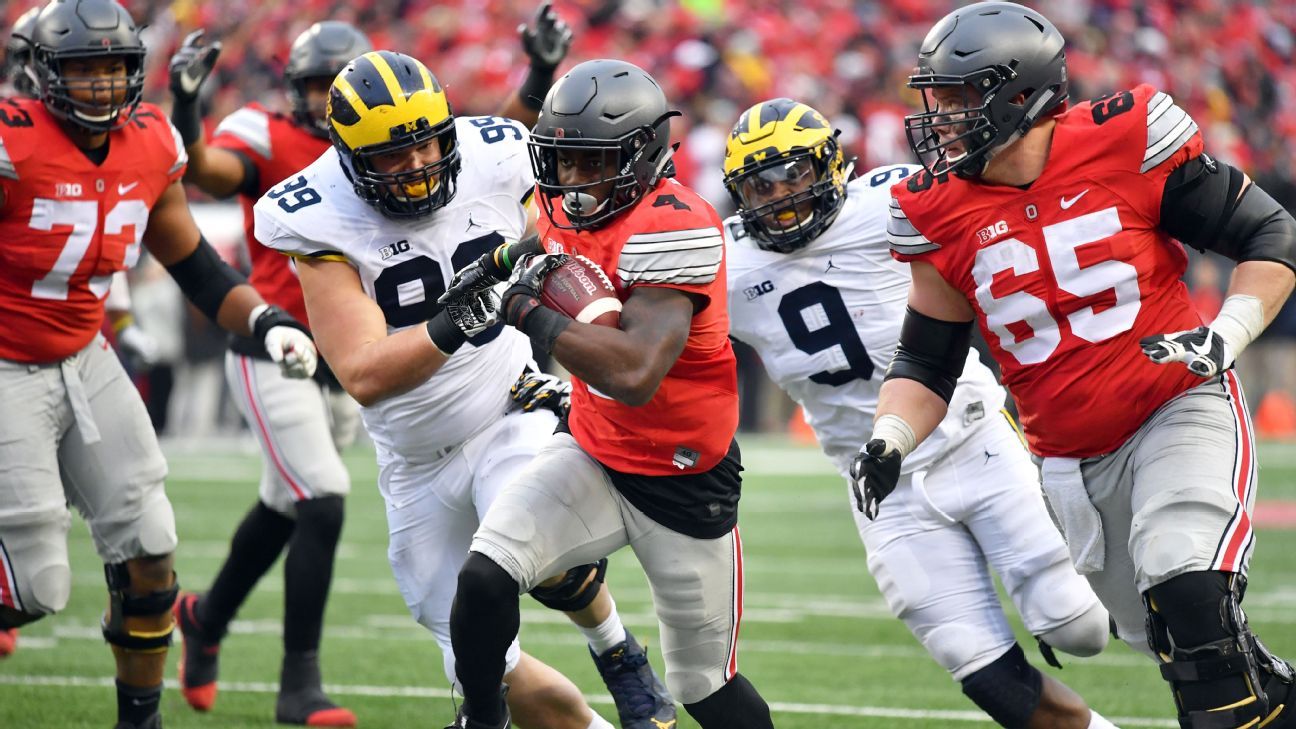As college football rivalries go, it’s hard to top The Game. When Michigan and Ohio State meet in the regular-season finale each year, a Big Ten championship game berth is often on the line. Granted, the rivalry has been one-sided of late, with the Buckeyes winning 15 of the past 16.
That doesn’t mean the games haven’t been competitive. And Thursday at 7 p.m. ET, ESPN will re-air the 2016 classic, which went to double overtime and turned on a controversial play. Ohio State was ranked No. 2 coming into the game and Michigan was ranked third.
Bill Connelly and Mark Schlabach give their takes on Michigan-Ohio State through the years to prime fans for the rebroadcast.
Does it make Ohio State-Michigan a better or worse rivalry that it tends to be so one-sided?
Bill Connelly: The most noteworthy thing about this rivalry is how many streaks there are. Ohio State has won 15 of the past 16 games, which is as one-sided as it has been since the 1920s, but Michigan went 12-3-1 from 1985 to 2000, Ohio State went 15-6-1 from 1954 to ’75, etc. This isn’t a big brother vs. little brother situation like a lot of rivalries — either the big state school vs. the ag school or, simply, the really successful school vs. the always-playing-from-behind one. It’s two huge, immensely successful programs, but one seems to often have sustained advantages over the other. Does that make it more interesting and unique? Or do we need Michigan to win another one of these at some point to make it a rivalry at all?
Mark Schlabach: The “series” dates to 1835, when the states were fighting over the Toledo Strip, a 468-square mile region along their borders. President Andrew Jackson negotiated a settlement, giving Ohio the Toledo Strip and Michigan the Upper Peninsula. If you’ve ever played golf in the U.P., you’d understand why the Buckeyes are still beating up the Wolverines. This is one of the storied contests in the sport’s history and one of the most anticipated games every season, but it’s kind of hard for me to call it a true rivalry anymore. Yeah, both sides don’t like each other. But OSU has absolutely owned Michigan since 2004, winning 15 of the past 16. The Buckeyes have done it against UM teams coached by Lloyd Carr, Rich Rodriguez, Brady Hoke and Jim Harbaugh, who is the first Wolverines coach to start his career 0-5 against “That School Down South.” OSU has won eight games in a row in the series; Michigan hasn’t lost nine straight to an opponent since Minnesota from 1901 to ’09. Let that sink in. Only one of the past six games in the series was decided by fewer than 11 points, and OSU scored 118 points in the past two, the most ever against Michigan in a two-game span by one opponent. Frankly, with the way OSU coach Ryan Day and his staff are recruiting, I don’t see that ugly trend ending anytime soon.
Connelly: Yeah, this streak is more about Ohio State at the moment than Michigan. The Wolverines certainly dealt themselves plenty of issues at the end of the 2000s and into the 2010s, but they’ve been, per my SP+ rankings, 10th, 6th, 13th, 10th and 10th in Harbaugh’s five seasons. We can debate whether UM should expect higher than that, but with a more mortal Ohio State, that’s still more than enough to score at least a couple of wins. But in that span, the Buckeyes have been second or better three times. We’ll see how Day manages a program long term — establishing and maintaining an overall program culture can trip up a lot of guys no matter how well they recruit — but this time last year it felt as if the Wolverines had a chance to turn the tables a bit. They … did not.
What’s your favorite Ohio State-Michigan game?
Connelly: Of the ones I’ve been alive to see (so, not 1973), I’ll go with 1996. Ohio State and John Cooper were in a very Harbaugh/Michigan predicament, held back by their inability to beat their rivals to date, and they got themselves knocked out of the national title race thanks to their eighth loss or tie in nine games in the series. Not only that, but the Buckeyes led 9-0 at halftime before Michigan backup quarterback Brian Griese led three scoring drives (and threw a long touchdown pass to Tai Streets) to push the Wolverines to a 13-9 lead. Nothing more heartbreaking than thinking, “Finally, we’re going to win!” only to lose. Not that Michigan fans would know anything about that.
Schlabach: Yeah, I’m sure Michigan fans still remember the 2016 edition, when the Wolverines blew a 17-7 lead and lost in one of the most controversial endings in the series. It was supposed to be the start of another Ten Year War between Harbaugh and Ohio State coach Urban Meyer. It was the only overtime contest in the 116-year history of the series, with Buckeyes tailback Curtis Samuel’s 15-yard touchdown run giving No. 2 OSU a 30-27 win over No. 3 Michigan in double overtime at the Horseshoe. Of course, Samuel’s game-ending run came immediately after a controversial fourth-and-1 play at the Michigan 16. Meyer opted not to try a short field, which would have tied the score and sent the game into a third OT. Instead, quarterback J.T. Barrett took the snap and ran into blocker A.J. Alexander’s back. Barrett looked to be short, but on-field officials ruled it a first down, and then replay officials upheld their call. Samuel ran into the end zone on the next play. Afterward, Harbaugh said, “That was not a first down. I’m bitterly disappointed with the officiating today.” Welcome to the crowd, Jim.
What has been the most important result in the series?
Connelly: I guess really this question should be “most important besides 2006.” But damn, that 2006 game felt like the biggest game in the world at the time. I think its vitality was lost over time with both Ohio State and Michigan getting thumped in their respective bowl games, but a No. 1 vs. No. 2 battle, and with Bo Schembechler dying the day before no less, was true “Game of the Century” material at the time. I had no emotional tie to that rivalry, and I got completely caught up in it. And it was a great game to boot! The right team won (Ohio State, of course), but most of the game’s stars acquitted themselves well, there were some plot twists, and Ted Ginn Jr. recovered the game-sealing onside kick. Not bad.
Schlabach: Good call for all the reasons explained. I’ll never forget the outrage when Florida was picked to play Ohio State in the BCS National Championship after the 2006 season, instead of a Michigan-Ohio State rematch. We all know how that turned out. That was a game for about, oh, five minutes. I’ll take you back about four decades earlier, when Woody Hayes’ team was absolutely dominating “That Team Up North” in 1968. He was enjoying the final moments of a 50-14 rout, when he inexplicably went for two after the Buckeyes’ final touchdown. When asked why, Hayes famously quipped, “Because I couldn’t go for three.” Woody hated the Wolverines that much. The next year, first-year Michigan coach Bo Schembechler, a former Hayes assistant, stunned the No. 1-ranked Buckeyes with a 24-12 upset, ending OSU’s 22-game winning streak. That outcome was the start of the Ten Year War between Hayes and Schembechler. Michigan had a 5-4-1 edge in the series from 1969 to ’78. That’s when the Michigan-Ohio State rivalry went from a Midwest grudge match to a national spectacle.
Connelly: And it goes without saying that, with a slightly different spot, Jim Harbaugh has beaten his rival at least once and, with a win over Wisconsin in the 2016 Big Ten title game, reached a CFP, too. An inch’s difference has completely defined his tenure.
Better moment: Ohio State players ripping down the M Club banner in 1973 or Marcus Hall flipping off the crowd in 2013?
Connelly: Marcus Hall’s middle finger was perfect for the Twitter age, and the M Club banner incident was perfect for watching decades later on grainy YouTube footage. That entire 1973 game was incredible. It went beyond the banner, beyond Michigan announcer Bob Ufer’s call (“THEY HAD THE AUDACITY, THE UNMITIGATED GALL …”) and, even though the game itself was a classic 10-10 tie, it went beyond the game itself. Big Ten teams voted to send Ohio State to the Rose Bowl instead of Michigan even though the Buckeyes had been there the year before. It was a moment that Schembechler was still shaking-mad about decades later. Rivalries are the lifeblood of the sport, and that might be one of the two or three best rivalry-defining moments the sport has seen.
Schlabach: The wildest thing about that vote in 1973 by Big Ten athletic directors was that Ohio State had played in the Rose Bowl the year before. Against USC. And was trounced by the Trojans 42-17. Wayne Duke, the Big Ten commissioner at the time, conducted a telephone vote (with no one else apparently monitoring) from his Chicago office and wouldn’t divulge the final tally. Duke did say the majority was influenced by Michigan quarterback Dennis Franklin’s broken collarbone. Schembechler was incensed and accused the league’s other coaches of “petty jealousies.” “I would really like to know how those schools voted and particularly how our sister school, Michigan State, voted,” Schembechler said. Ohio State validated the vote by turning the tables on the Trojans 42-21. Can you imagine if today Auburn voted whether Alabama or LSU should go to the SEC championship game? Or if Washington State voted whether Washington on Stanford went to the Rose Bowl? That would be some fun.
Connelly: It blows my mind the conference held out that long in continuing to send only one team to a bowl each year. The Pac-8/Pac-10, too. As petty and friendly to its royalty as this sport is in 2020, it was so, so much more 50 years ago.
Who would you take to coach your team: prime John Cooper or prime Jim Harbaugh?
Schlabach: Cooper. Sure, his Ohio State teams lost 10 games (and tied one more) against Michigan in 13 seasons from 1988 to 2000. But that’s still two more games than Harbaugh’s teams have won in the series. From 1993 to ’97, the Buckeyes were ranked in the top five four times entering the Michigan game. They lost to the Wolverines every time. If only there had been a playoff back then.
Connelly: Give me Harbaugh. For now. Cooper inherited a program that had averaged nine wins per year over the previous decade and went just 35-21-3 in his first five seasons before finally getting rolling. We’ll see if Harbaugh has a run in him like what Cooper put together in years 6-11 (over 10 wins per year and three top-six finishes), but inherited a shakier program and has gone 47-18 so far. I’m less sure than ever that he’s going to get a leg up on his extremely well-organized rival, but he’s winning 80% of his other games. So that’s something?


